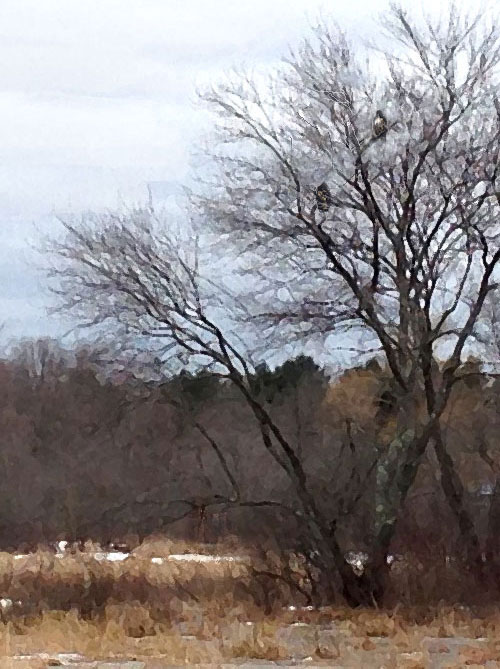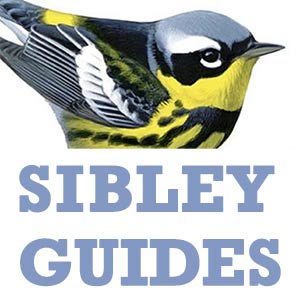
By the end of February, even in cold and snowy Massachusetts, Red-tailed Hawks are courting and forming pairs in preparation for nesting. It’s common to see the male and female of a pair sitting close to each other in a tree, and this provides a very powerful clue to identification.
Hawks are generally solitary and territorial, and will not tolerate another hawk nearby. The only exception is mated pairs. You won’t see two Rough-legged Hawks, or a Red-tailed and a Red-shouldered Hawk, sharing a tree like this on the wintering grounds. Therefore, whenever you see two hawks sitting this close to each other, it’s safe to assume that they are the same species and that they are nesting nearby, which greatly reduces the number of candidate species.
Habitat also helps, and since Red-tailed Hawk is the only large open-country raptor nesting in Massachusetts it’s easy to identify these two birds as Red-tails based on nothing more than their size and their choice of perches.


I appreciate this fine reminder that learning all there is to learn about a bird is relevant to “knowing” it. I put quotes because there can be various interpretations of “knowing” a bird. As a naturalist and guide when someone asks me “What is it?”, in response I ask about what it is doing and where it is. I believe that educating folks on how birds behave, where they are more likely to spend time, and who they hang out with is essential. Thanks for posting.
Bechard and Schmutz in the BNA account say that winter territoriality has not been reported in Ferruginous Hawk and several birds may perch within 50 meters of each other. I have seen two in the same tree in southern California but not as close as in the photo above.
Sorry to come to this post so late but wanted to post a question re RTHAs not sharing trees on wintering grounds. So is this true only of migratory RTHAs? The reason I ask is that I follow a pair of RTHAs that nest on the Cornell campus in Ithaca, NY. They are resident, not migratory. The male and female are seen together throughout the winter.
Yes, that’s a good point. Many adult Red-tailed Hawks are resident, and pairs stay together all winter. Here in Massachusetts they seem to get a lot more interested in each other in the late winter, and its more common to see a pair sitting close together, but possible all winter long. Other buteos that are just passing through an area won’t do that.
Hello Mr Sibley,
I really appreciate these simple identification tips – they are quite helpful and easy to digest. Thanks!
Side note – I’d love to see you post blog updates to Google+. There is are quite a few active birding and bird photography communities there, and I find myself using it as a primary source of online info (and tend to forget about your blog).
Anyway…thanks again for all of the work you do!
Glad I found this info. The other day, near the Manchester, NH airport, I saw what I thought was an unusually fat hawk perched in a tree, but as I drove by, I saw that it was two hawks sitting very close side by side. I have seen a red-tail in the vicinity and these were the right size and shape tho I could not pull over for a positive ID or photo.
I’m charmed to know they were a mated pair. Love is in the air!
Yes, even with all the snow on the ground, the birds are planning for spring. There is hope.
Thank you so much for this information. I’m new to learning to identify large birds, as we’ve recently moved, and am thrilled to know the birds in the tree, at the back of our property, are indeed a mated pair of Red Tailed hawks. This is so exciting!
David, I am interested in your views about whether migrant adult RTHAs winter in pairs, or not. Since they have leap frog migration, our MA birds may be all or nearly all year-round residents. I understand many migrant RTHA winter in Mexico or southwards. But RTHA wintering in US S of New England’s latitude are probably combinations of all year residents and migrants. Does it matter whether the birds are migrant (not on their breeding ground) vs all year residents as to whether they will winter in proximity to each other?
Thank you for your information.
Hi Nora, I don’t think there’s any evidence of pairs of Red-tailed Hawks staying together through migration and winter, so this behavior should indicate a pair on a breeding territory. That is the main value of it as a field mark – it tells you that these birds are planning to nest locally, so it rules out species (or subspecies or populations) that are just wintering or passing through.
I just saw a raptor of some sort here in Downers Grove, Illinois. It flew across the street as I was driving, very low flying maybe 10 feet from the road surface. It crossed from driver’s side to passenger (north to south) and rested in a medium sized Tree. A red winged blackbird or two were in pursuit of it. So I made a right turn into a small entrance to a larger parking lot on the right and got out of car and took several pictures of it. After a couple of minutes a second raptor same species flew out from a denser part of the same tree. It startled me because I did not see it while I was watching the first bird. Then after another minute the first one took off back to the north side of the road and went into a dense low tree. Then it flew up gaining altitude, while heading east in the same side of the road, landing near the top of a much taller tree, where I lost track of it. I could not identify it because it’s chest was almost solid grey, a very light grey, almost beige. There was no striping or banding that I could see other than the tail. It’s head in contrast to the chest and waist was a dark brown and as it sat perched in the tree, the outside of it’s tucked in wings appeared to match it’s head with a dark brown hue. As the second one flew away I could see a light colored underside to the wing which matched the chest. Ii have a couple picture and would like to send them to you. I am facing east o. The southern side of warrenville road
Pingback: A Red-Tailed Surprise – Wildlife Leadership Academy
Hi David,
I just want to thank you for this post! There’s a tall tree (looks like a fir) with the upper 5 feet of it completely bare of any leaves about a block away from my house. At around 12:30pm today I noticed two RTHAs sitting very close together at the very top! It’s the tallest tree in the area, so it makes for a great perch. I kept checking throughout the day and they were both in the same spot until about 5:30pm when one flew away. It’s now 6:15pm and the one is still there. I’m just north of Boston and we had severe thunderstorm warnings today, and these two stuck it out the whole time. I was initially worried my hunt for more information about this pair would take more time than it did- I’m very grateful for your post! How lucky are we when we have these opportunities to observe bird behavior from our own backyards!
All the best,
Katie
Pingback: How Do You Identify A Red Tailed Hawk? – Ploverbirds.com
Pingback: Do Cooper’s Hawks Return To The Same Nest? – Ploverbirds.com
Pingback: Are Harris Hawks Native To UK? – Ploverbirds.com
Pingback: Do Red-shouldered Hawks Travel In Pairs? – Ploverbirds.com
I saw two RTH side by side in a backyard tree. They have been flying around together for a week and one is very vocal. Would this be a juvenile and parent or mates? One was larger. The smaller one seemed to be doing all the talking. Time of year is mid June in midwestern USA.